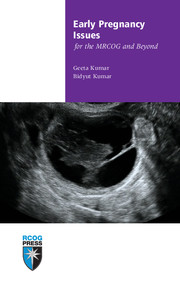Book contents
- Frontmatter
- Contents
- Dedication and acknowledgement
- About the authors
- Abbreviations
- Preface
- 1 Embryogenesis and physiology
- 2 Miscarriage
- 3 Recurrent miscarriage
- 4 Ectopic pregnancy
- 5 Trophoblastic disease
- 6 Hyperemesis gravidarum
- 7 Abdominal and pelvic pain in early pregnancy
- 8 Prescribing issues
- 9 Ultrasound and screening
- Further reading
- Index
- Published titles in the MRCOG and Beyond series
4 - Ectopic pregnancy
Published online by Cambridge University Press: 05 July 2014
- Frontmatter
- Contents
- Dedication and acknowledgement
- About the authors
- Abbreviations
- Preface
- 1 Embryogenesis and physiology
- 2 Miscarriage
- 3 Recurrent miscarriage
- 4 Ectopic pregnancy
- 5 Trophoblastic disease
- 6 Hyperemesis gravidarum
- 7 Abdominal and pelvic pain in early pregnancy
- 8 Prescribing issues
- 9 Ultrasound and screening
- Further reading
- Index
- Published titles in the MRCOG and Beyond series
Summary
Ectopic pregnancy is pregnancy located outside the uterine cavity. This condition occurs in approximately 1/90 pregnancies (just over 1%) in the UK. Evidence suggests that the incidence of ectopic pregnancies has been rising. While this increase is for the most part aided by better diagnostic techniques, early diagnosis also plays a role by identifying ectopic pregnancies that may otherwise have spontaneously resolved. Although it rarely presents as a life-threatening emergency in the UK, ectopic pregnancy still remains the leading cause of maternal death in the first trimester and contributed to ten maternal deaths in the triennium 2003–2005. Box 4.1 lists the aetiology and predisposing factors for ectopic pregnancy.
BOX 4.1 AETIOLOGY AND PREDISPOSING FACTORS FOR ECTOPIC PREGNANCY
• Previous ectopic pregnancy
• Past or present pelvic inflammatory disease: the most common cause being infection with Chlamydia trachomatis
• Pregnancy with intrauterine contraceptive device in place
• Pregnancy resulting from failure of progestogen-only pill
• Previous pelvic surgery, including caesarean section and tubal surgery (including sterilisation, appendicectomy)
• Pregnancy following assisted conception techniques
• Pregnancy in women over 40 years of age
• Pregnancy in women who smoke
Presentation
The large majority (95%) of ectopic pregnancies occur in the fallopian tube, the ampullary part of the tube being the most common implantation site (70%) followed by isthmic (12%) and fimbrial (11.1%) locations.
- Type
- Chapter
- Information
- Early Pregnancy Issues for the MRCOG and Beyond , pp. 42 - 60Publisher: Cambridge University PressPrint publication year: 2011



